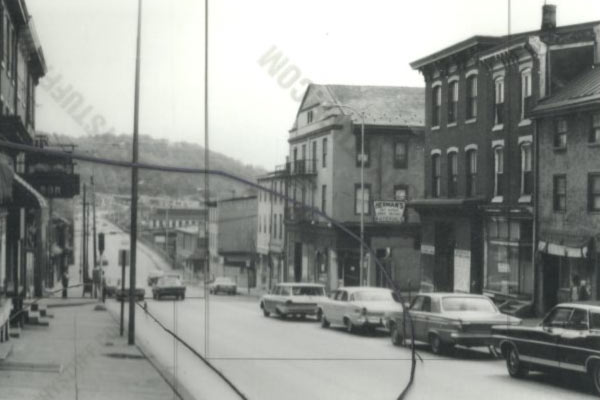
Black History Month – A Brutal Murder By Jack Coll
February 19, 2017
Conshohocken Urban Redevelopment
March 7, 2017Black History Month – Medgar Evers He Fought for his Country, Our Country by Jack Coll

Medgar Evers
He Fought for his Country-Our Country
Then He Fought for his Country
By Jack Coll
I didn’t know much about Medgar Evers, but I did know this, he was an American civil rights activist from Mississippi. He was a college graduate and he was a World War II veteran who fought in the Battle of Normandy in June of 1944. And by the way he was buried at Arlington National Cemetery with full military honors.
Evers was assassinated by a coward segregationist and died, he was just 37 years old.
Bob Dylan wrote a song about Medgar Evers back in 1963 following his assassination. In the history of the civil rights movement the early 1960’s were a dangerous time, in many of the Southern States the white man was king and at times someone like Dylan speaking up for the African American population was taking his own life into his own hands with the lyrics he was writing back then. Any white man who spoke on behalf of the black man became an outcast with his friends and neighbors. In Dylan’s song called “Only A Pawn In Their Game,” which was written about Medgar Evers part of the lyrics read:
He’s taught in his school
From the start by the rule
That the laws are with him
To protect his white skin
To keep up his hate
So he never thinks straight
‘bout the shape that he’s in
But it ain’t him to blame
He’s only a pawn in their game
In 1963 Dylan was touring the country and these were powerful lyrics, back then Dylan wrote a lot of protest songs about everything from the corrupt politician’s to the social injustices.
Medgar Evers was born in Decatur, Mississippi in 1925, he was the third of five children. The Evers family owned a small farm and Medgar walked twelve miles a day to attend segregated schools where he earned a high school diploma.
Medgar served his country in the United States Army during World War II from 1943 to 1945. He was sent to the European Theatre and he fought in the Battle of Normandy in June 1944. By war’s end Evers was honorably discharged as a sergeant.
Following the war Evers enrolled at Alcorn College, a historically black college, (currently Alcorn State University). He majored in business, competed on the debate team, played on the football and track teams, sang in the choir and was junior class president. He graduated in 1952 with a Bachelor of Arts degree.
While in college Evers married a classmate Myrlie Beasley, together they had three children. The couple moved to Mound, Mississippi a town developed by African Americans, where Evers became a salesman for T. R. M. Howard’s Magnolia Mutual Life Insurance Company. The 27 year old Evers also was president of the Regional Council of Negro Leadership (RCNL) Evers helped organize the RCNL’s boycott of gasoline stations that denied blacks the use of the station’s restrooms.
In 1954, Evers applied to the segregated University of Mississippi Law School, but his application was rejected because of his race. That same year the US Supreme Court had ruled that segregation of public schools, which included state universities was unconstitutional.
The University of Mississippi didn’t allow a Black applicant to attend the University until 1962 when James Meredith gained entrance. Medgar Evers was the head of the state chapter of the NAACP at that time and had advised Meredith in a successful effort to gain entrance into the state run university.
In 1954, Evers was named the NAACP’s first field secretary for Mississippi. Evers helped organize and set up new local chapters of the NAACP. Evers was on the front lines helping to organize the Biloxi wade-ins protesting against segregation of public beaches on the Mississippi Gulf Coast. Back in the 1930’s—1950’s most beach fronts in the United States were segregated including Atlantic City, known as the “Playground of America,” Atlantic City’s segregated beach was known as “Chicken Bone Beach.”
Evers civil rights leadership and investigative work made him a target of white supremacist. The White Citizens Council was founded in Mississippi, with numerous local chapters, to resist integration of schools and civil rights goals. In the weeks before Evers death, the leader encountered new levels of hostility. His public investigations into the 1955 lynching of teenaged Emmitt Till and his vocal support of Clyde Kennard had made him a prominent black leader. On May 28, 1963, a Molotov cocktail was thrown into the carport of his home. On June 7, 1963, Evers was nearly run down by a car after he emerged from the NAACP office in Jackson.
Evers was doing great work advancing the civil rights movement and because of it on the morning of June 12, 1963, just hours after President John F. Kennedy’s nationally televised Civil Rights address, Evers pulled into his driveway after returning from a meeting with NAACP lawyers. As Evers was getting out of his car carrying NAACP T-shirts that read, “Jim Crow Must Go” Evers was hit in the back with a bullet fired from a rifle by a coward hiding in the bushes, the bullet ripped through his heart. He was rushed to the hospital in Jackson, Mississippi where he was refused entry because of his race. His family pleaded and explained who he was and was finally admitted, less than an hour later he died on a hospital gurney.
An estimated 5,000 people marched from the Masonic Temple on Lynch Street to the Collins Funeral Home in Jackson Mississippi. A number of civil rights leaders including Reverend Martin Luther King and other civil rights leaders led the procession.
Evers was buried on June 19, in Arlington National Cemetery, where he received full military honors before a crowd of more than 3,000.
Two day after Evers was buried Byron De La Beckwith, a fertilizer salesman and member of the White Citizens Council, and later a member of the Ku Klux Klan was arrested for Evers murder. All-white juries twice that year deadlocked on De La Beckwith’s guilt and failed to reach a verdict. At the time, most blacks were disenfranchised by Mississippi’s constitution and voter registration practices, meaning blacks were also excluded from juries, which was based on registered voters.
Thirty years later De La Beckwith was prosecuted by the state based on new evidence in 1994. During the trial, the body of Evers was exhumed from his grave for an autopsy. De La Beckwith was convicted of murder on February 5, 1994, he died in prison at the age of 80 in January 2001.
On June 28, 1992, the city of Jackson, Mississippi, erected a statue in honor of Evers. All of Delta Drive, (part of U. S. Highway 49) in Jackson was renamed in Evers honor. In December 2004, the Jackson City Council changed the name of the city’s airport to “Jackson-Medgar Wiley Evers International Airport in his honor
Evers widow Myrlie Evers became a noted activist in her own right, eventually serving as chairperson of the NAACP. Medgar’s brother Charles Evers returned to Jackson in July 1963 and served briefly with the NAACP in his slain brother’s place. He remained involved in Mississippi civil rights activities for many years, he became the first African-American Mayor elected in the state in 1969, and resides in Jackson.
In 2017, President Barack Obama designated the Medgar and Myrlie Evers House as a National Historic Landmark.
In 1963 when the Medgar Evers assassination happened and race was a hot-button, Musician Bob Dylan penned a song and recorded it called “Only A Pawn in Their Game.” Dylan didn’t mix words and you didn’t have to read between the lines to know and understand what he was writing and singing about in this song:
“Only A Pawn In Their Game”
Written By Bob Dylan
A bullet from the back of a bush took Medgar Evers’ blood
A finger fired the trigger to his name
A handle hid out in the dark
A hand set the spark
Two eyes took the aim
Behind a man’s brain
But he can’t be blamed
He’s only a pawn in their game
A South politician preaches to the poor white man
“You got more than blacks, don’t complain
You’re better than them, you been born with white skin” they explain
And the Negro’s name
Is used in plain
For the politician’s gain
As he rises to fame
And the poor white remains
On the caboose of the train
But it ain’t him to blame
He’s only a pawn in their game
The deputy sheriffs, the soldiers, the governors get paid
And the marshals and cops get the same
But the poor white man’s used in the hands of them all like a tool
He’s taught in his school
From the start by the rule
That the laws are with him
To protect his white skin
To keep up his hate
So he never thinks straight
‘Bout the shape that he’s in
But it ain’t him to blame
He’s only a pawn in their game
From the poverty shacks, he looks from the cracks to the tracks
And the hoof beats pound in his brain
And he’s taught how to walk in a pack
Shoot in the back
With his fist in a clinch
To hang and to lynch
To hide ‘neath the hood
To kill with no pain
Like a dog on a chain
He ain’t got no name
But it ain’t him to blame
He’s only a pawn in their game
Today, Medgar Evers was buried from the bullet he caught
They lowered down as a king
But when the shadowy sun sets on the one
That fired the gun
He’ll see by his grave
On the stone that remains
Carved next to his name
His epitaph plain:
Only a pawn in their game.
For years critics said Dylan couldn’t sing, and his guitar playing had a lot to be desired, but no-one ever said he couldn’t write. And because of his lyrics and his ability to speak-up and speak-out, Dylan became known as a “Voice for a generation,” and it was because of his voice that racial injustices were kept in the headlines.
No-body was writing what Dylan was writing about, The Beatles were writing and singing stuff like “I wanna Hold Your Hand,” The Rolling Stones were cranking out pop-tunes like “Get Off My Cloud,” and the Beach Boys with “Sloop John B.”
Protest songs were plenty in the early 1960’s with Peter, Paul and Mary, Joan Baez, Donovan and many others, but Dylan’s words cut right to the cause, and America listened to his words and agreed, the United States of America SHOULD be, no place for racial hate.
EDITOR’S NOTE:
In an effort to bring the reader the facts, much of this information pertaining to Medgar Evers was gathered from Wikipedia, and at times was reproduced word-for-word from the site.

